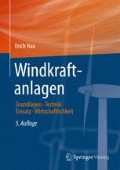Zusammenfassung
Der Rotor steht am Anfang der Wirkungskette einer Windkraftanlage. Seine aerodynamischen und dynamischen Eigenschaften sind deshalb in mehrfacher Hinsicht prägend für das gesamte System. Die Fähigkeit des Rotors, einen möglichst hohen Anteil der die Rotorkreisfläche durchströmenden Windenergie in mechanische Arbeit umzusetzen, ist offensichtlich eine direkte Folge seiner aerodynamischen Eigenschaften.
Access this chapter
Tax calculation will be finalised at checkout
Purchases are for personal use only
Preview
Unable to display preview. Download preview PDF.
Literatur
Glauert, H.:Windmills and Fans, Durand, F.W. (Hrsg); Aerodynamic Theory, Berlin, Julius Springer, 1935
Hütter, U.: Beitrag zur Schaffung von Gestaltungsgrundlagen fürWindkraftwerkWeimar: Dissertation 1942
Schmitz, G.: Theorie und Entwurf von Windrädern optimaler Leistung, Wiss. Zeitschrift der Univ. Rostock, 5. Jahrgang, 195âµâ„ââ
Wilson, R.E.; Lissaman, P.B. S.:Applied Aerodynamics ofWind PowerMachines, Oregon State University, 1974
Schlichting, H., Truckenbrodt, E.: Aerodynamik des Flugzeuges, 1. Auflage, Springer, 1958
Gasch, R.; Twele, J.:Windkraftanlagen, Teubner, 2005
Sörensen, J. N. (Hrsg.):VISCWINDViscous Effects onWind Turbine Blades, Department of Engineering, Technical University of Denmark, 1999
Enercon: Firmen-Broschüre, 2006
Lissaman, P.B.S., Energy Effectiveness of Arbitrary, Array of Wind Turbines, AIAA paper 79-0114, 1979
Ainslie, J.F.: Calculating of Flow Field in theWake of Wind Turbines, Journal of Wind Engineering and Industrial Aerodynamics, 27, 1988, Elsevier Science Publishers, B.V. Amsterdam
Crespo, A.; Fraga, E.; Hernandez, J.; Luken E.: Analysis ofWind TurbineWakes, Euroforum New Energies, Saarbrücken 24–28 Okt. 1988
Albers, A.; Beyer, H.G.; Kroankowski, Th.; Schild M.: Results forma JointWake Interference Research Programm European CommunityWind Energy Conference, Lübeck– Travemünde 8–12 Mai, 1993
Pedersen, M.B.; Nielsen, P.: Description of the two Danish 630 kW Wind Turbines Nibe A and Nibe B. Kopenhagen: 3. BHRA International Symposium onWind Energy Systems 26–29 Aug., 1980
Miller,D.R.; Sirocky, P. J.: Summary of NASA/DOEAileron-Control Development Program of Wind Turbines. Cleveland, Ohio: NASA Lewis Research Center
Wentz,W.H.; Calhoun, J.T.:Analytical Studies of NewAirfoils forWind Turbines.Wind Turbine Dynamics. Cleveland, Ohio: NASA Conference Publication 2185, 24–26 Feb., 1981
Björck, A.; Thor S.-E.: Dynamic Stall and 3D Effects, European Union Windenergy Conference 20–24 May 1996, Göteborg, Sweden
Spera, D.A. (Ed.):Wind Turbine Technology, ASME Press, New York, 1994
Divalentin, E.: The Application of Broad Range Variable Speed forWind Turbine Enhancement, EWEA Conference, 7–9 Oct., 1986
Avolio, S.; Calo, C.; Foli, U.; Casale, C; Sesto, E.: GAMMA-60 1‚5 MW Wind Turbine Generator, EUWEC 90, 10–14 Sept., 1990, Madrid
Abbott, I.H.: Theory of Wing Sections: Dover Publications Inc., New York, 1958
Schlichting, H., Truckenbrodt, E.: Aerodynamik des Flugzeuges, Neuauflage, Springer, 2001
Wortmann, F. X.: Tragflügelprofile fürWindturbinen, Seminar und StatusreportWindenergie, KFA Jülich, 23–24 Oktober 1978
Gifford Technology: Comparison of Airfoil Performance. Southampton, Persönliche Mitteilung, 1986
McGhee, R. C.; Beasley, W.D.: Wind Tunnel Results for a Modified 17-Percent-Thick Low-Speed Airfoil Section. NASA Technical Paper 1919, 1981
Rohrbach, C.; Wainausky, I. H.; Worobel, R.: Aerodynamics ofWind Turbines, Hamilton Standard, 1977. ERDA Contract NoE (11-1)-2615
De Vries, O.: Fluid Dynamic Aspects of Wind Energy Conversion. AGARD-AG-243, 1979
Corrigan, R.D.; Viterna, L.A.: Free Yaw Performance of the MOD-0 Large Horizontal Axis 100 kWWind Turbine. Cleveland: Lewis Research Center, 44135, Ohio, 1981
Nebel, M.: Brechungsverfahren für Vertikalachsenrotoren, Zeitschrift für Flugwissenschaften undWeltraumforschung, 9 (1985), Heft 5
Strickland, J.H.; Webster, B.T.; Nguyen, T.: A Vortex Model of the Darrieus Turbine: An Analytical and Experimental Study.ASME Paper No 79, 1979
Fallen,M.; Ziegler, J.: Leistungsberechnungen für einenWindenergiekonverter mit vertikaler Achse. Brennstoff-Wärme-Kraft, Nr. 2, 1981
Braasch, R.H.: The Design, Construction, Testing and Manufacturing of Vertical Axis Wind Turbines. Second International Symposium of Wind Energy Systems, Oct. 1978
McAnulty,K.:AnAppraisal of Straight BladedVerticalAxis andHorizontal AxisWindmills, BEWAWind Energy Conference, Reading, 1983
Wortmann, F. X.: Erstellung eines Böengenerators für die Entwicklung von Windturbinen. Seminar und StatusreportWindenergie, KFA Jülich, 11–13 Oktober 1982
Pearson, G.; Gilhaus, A.: Wind Tunnel Measurement on a 1/25 Scale Model of the Growian Rotor. Interner MAN-Report, 1981
Mickeler, S.; Schultes, K.; Mayer, M.: A Consistent Shutdown Procedure and Parking Position for the Single Bladed Rotor: European Wind Energy Conference EWEC’86, Rom, 7–9 Okt. 1986
Körber, F.; Besel, G.:Meßprogramm Growian.BMFT-Forschungsvorhaben Nr. 03 E 45 12A 3, 1988
Garrad,A.D.: Dynamic Loads inWind Farms. EU-Forschungsvorhaben JOUR-0084- C, 1992
Author information
Authors and Affiliations
Corresponding author
Rights and permissions
Copyright information
© 2014 Springer-Verlag Berlin Heidelberg
About this chapter
Cite this chapter
Hau, E. (2014). Aerodynamik des Rotors. In: Windkraftanlagen. Springer Vieweg, Berlin, Heidelberg. https://doi.org/10.1007/978-3-642-28877-7_5
Download citation
DOI: https://doi.org/10.1007/978-3-642-28877-7_5
Published:
Publisher Name: Springer Vieweg, Berlin, Heidelberg
Print ISBN: 978-3-642-28876-0
Online ISBN: 978-3-642-28877-7
eBook Packages: Computer Science and Engineering (German Language)

